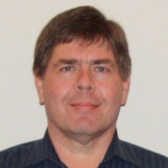

Walden School of Liberal Arts, Provo, Utah
7, 8, 9, 10, 11, 12
David Black has taught at public, private, and charter schools and applied technology colleges in Utah and California for 22 years. He teaches a combination of physical science (chemistry, physics, astronomy) and computer application (media design, video production, and 3D animation) classes at Walden School of Liberal Arts in Provo, Utah.
His students have completed many exciting projects that integrate science and authentic data with media design and computer technology. For example, his students designed 3D animations of the origin and features of the Moon for the NASA Lunar Science Institute. They filmed and edited a video lesson plan on astronomy for MIT. They have worked with Mars scientists to predict possible sandstorms that could hinder the Mars Exploration Rovers. They also created a 2-hour documentary for KUED, Salt Lake City’s PBS station, on the history of AM radio, called “AM to FM: Three Decades of Radio in Utah.”
David is a SOFIA Airborne Astronomy Ambassador and flew on SOFIA in June, 2013. He has helped to plan and present educator workshops for the NASA Explorer Schools program at the Jet Propulsion Laboratory. David is also a frequent presenter at state and national educator conferences and a member of the Aerospace Advisory Board for the National Science Teachers Association.
As of January 2014, students at Walden School are editing video footage and creating 3D models of SOFIA, NASA’s airborne infrared observatory as well as preparing to do original astronomy with Caltech’s NITARP program in 2014.
Mr. Black was a semi-finalist for the national Air Force Association 2017 Teacher of the Year.
NITARP Educator Alumni Wendi Laurence, Peggy Piper, David Black, and Student Alumni Connor Laurence, presented on their NITARP research at the 2nd Annual NSTA Aerospace Share-a-thon in Chicago this March.
Mr. Black been selected for the Yager Award through NSTA, and will get a free trip to Omaha next summer. He adds, "Not as fun as NITARP, but it's hard to beat last summer."
The 2014 class has been announced! This year, we had many fewer spots to offer, and still 4.5 times as many educators applied as we had spots. Caroline Odden and John Gibbs will be our mentor educators for this class. Look for results of their projects in January 2015!
I already had a pretty good idea of how astronomers do science, but NITARP helped me see more exactly how data is collected, processed, and analyzed. It helped me also see that I can do astronomy myself, and can make a contribution beyond my own classroom. Not only can I analyze astronomical data to find scientifically useful results, but I can publish my work as a poster and be part of this community. I did not feel like a stranger or usurper or even out of place – it felt like I belonged.
I found [astronomers] to be approachable, willing to talk with mere mortals such as myself, and more than happy to explain their work. Everyone I talked with at poster sessions and elsewhere was enthusiastic and excited about their discoveries. It was the kind of community of learners that I try to model in my classroom, and it will be the most important thing I take back from the conference to share with my students – that astronomers are regular people who are happy to share what they know. The second most important thing is that they can do this, too (and will be doing this) and there are no barriers to their becoming professional astronomers if they want to.